Reviews are in for the 20th Storage Developer Conference (SDC) and they are thumbs up! The 2017 SDC was the largest ever- expanding to four full days with seven keynotes, five SNIA Tutorials, and 92 sessions. The SNIA Technical Council, who oversees conference content, compiled a rich agenda of 18 topic categories 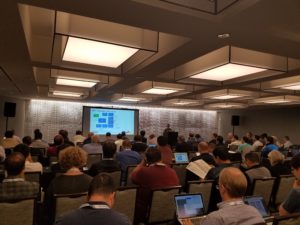 focused on Read More
focused on Read More
Category: Standards
Take the 2017 Archive Requirements Survey!
![]()
by Samuel A. Fineberg, Co-chair, SNIA LTR TWG

Ten years ago, a SNIA Task Force undertook a 100 Year Archive Requirements Survey with a goal to determine requirements for long-term digital retention in the data center. The Task Force hypothesized that the practitioner survey respondents would have experiences with terabyte archive systems that would be adequate to define business and operating system requirements for petabyte-sized information repositories in the data center. Read More
Does Your World Include Storage? Don’t Miss SDC!
Whether storage is already a main focus of your career or may be advancing toward you, you’ll definitely want to attend the flagship event for storage developers – and those involved in storage operations, decision making, and usage – SNIA’s 19th annual Storage Developer Conference (SDC), September 11-14, 2017 at the Hyatt Regency Santa Clara, California. Read More
Around the World, It’s a Persistent Memory Summer
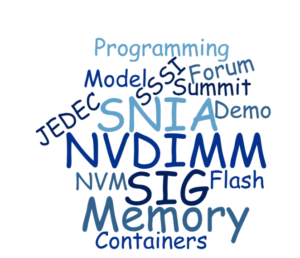 ent memory solutions available today and SNIA is a sponsor in the exhibit hall. Read More
ent memory solutions available today and SNIA is a sponsor in the exhibit hall. Read More
Your Questions Answered on Non-Volatile DIMMs
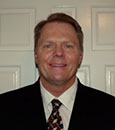 by Arthur Sainio, SNIA NVDIMM SIG Co-Chair, SMART Modular
SNIA’s Non-Volatile DIMM (NVDIMM) Special Interest Group (SIG) had a tremendous response to their most recent webcast: NVDIMM: Applications are
by Arthur Sainio, SNIA NVDIMM SIG Co-Chair, SMART Modular
SNIA’s Non-Volatile DIMM (NVDIMM) Special Interest Group (SIG) had a tremendous response to their most recent webcast: NVDIMM: Applications are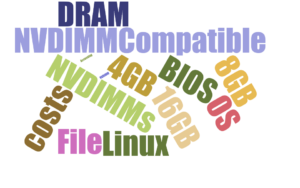 Here! You can view the webcast on demand.
Viewers had many questions during the webcast. In this blog, the NVDIMM SIG answers those questions and shares the SIG’s knowledge of NVDIMM technology.
Have a question? Send it to nvdimmsigchair@snia.org.
1. What about 3DXpoint, how will this technology impact the market? Read More
Here! You can view the webcast on demand.
Viewers had many questions during the webcast. In this blog, the NVDIMM SIG answers those questions and shares the SIG’s knowledge of NVDIMM technology.
Have a question? Send it to nvdimmsigchair@snia.org.
1. What about 3DXpoint, how will this technology impact the market? Read More
SNIA Ranked #2 for Storage Certifications – and Now You Can Take Exams at 900 Locations Worldwide
The SNIA Storage Networking Certification Program (SNCP) provides a strong foundation of vendor-neutral, systems-level credentials that integrate with and complement individual vendor certifications. Its four credentials – SNIA Certified Storage Professional; SNIA Certified Storage Engineer; SNIA Certified Storage Architect; and SNIA Certified Storage Networking Expert – reflect the advancement and growth of storage networking technologies, and establish a uniform standard by which individual knowledge and skill sets can be evaluated, thereby providing employers in the storage industry with an independent assessment of the individual. Read More
SNIA Swordfish is Swimming Fast – Catch Up Now!
 If you haven’t caught the updates on SNIA SwordfishTM lately, please read on because it’s swimming fast! The new SNIA specification offers a unified approach to managing storage and servers in environments like hyperscale and cloud infrastructures. SNIA’s Scalable Storage Management Technical Work Group (SSM TWG) just announced completion of Version 1.0.3. The new version reflects specification enhancements in multiple areas plus a User’s Guide, multiple new use cases and a new document section.
If you haven’t caught the updates on SNIA SwordfishTM lately, please read on because it’s swimming fast! The new SNIA specification offers a unified approach to managing storage and servers in environments like hyperscale and cloud infrastructures. SNIA’s Scalable Storage Management Technical Work Group (SSM TWG) just announced completion of Version 1.0.3. The new version reflects specification enhancements in multiple areas plus a User’s Guide, multiple new use cases and a new document section.
“Because SNIA Swordfish is an extension to DMTF’s (Distributed Management Task Force) open industry Redfish standard, it specifies the same RESTful interface and utilizes JavaScript Object Notation and Open Data Protocol to help customers integrate solutions within their existing tool chains,” said Don Deel, Chairman, SNIA Storage Management Initiative. “The SSM TWG members responsible for helping develop SNIA Swordfish represent many of the leading companies in the storage industry today, including Broadcom, Dell EMC, HPE, Intel, Microsoft, NetApp, Nimble Storage and VMware.”
standard, it specifies the same RESTful interface and utilizes JavaScript Object Notation and Open Data Protocol to help customers integrate solutions within their existing tool chains,” said Don Deel, Chairman, SNIA Storage Management Initiative. “The SSM TWG members responsible for helping develop SNIA Swordfish represent many of the leading companies in the storage industry today, including Broadcom, Dell EMC, HPE, Intel, Microsoft, NetApp, Nimble Storage and VMware.”
You can also keep up with the latest Swordfish updates by continually visiting the SNIA Swordfish website. If you’re interested in helping shape the future of storage management by getting involved in the development of SNIA Swordfish, please e-mail storagemanagement@snia.org.
SNIA Swordfish is Swimming Fast – Catch Up Now!
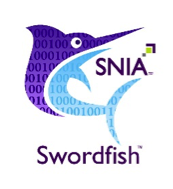 If you haven’t caught the updates on SNIA SwordfishTM lately, please read on because it’s swimming fast! The new SNIA specification offers a unified approach to managing storage and servers in environments like hyperscale and cloud infrastructures. SNIA’s Scalable Storage Management Technical Work Group (SSM TWG) just announced completion of Version 1.0.3. The new version reflects specification enhancements in multiple areas plus a User’s Guide, multiple new use cases and a new document section.
If you haven’t caught the updates on SNIA SwordfishTM lately, please read on because it’s swimming fast! The new SNIA specification offers a unified approach to managing storage and servers in environments like hyperscale and cloud infrastructures. SNIA’s Scalable Storage Management Technical Work Group (SSM TWG) just announced completion of Version 1.0.3. The new version reflects specification enhancements in multiple areas plus a User’s Guide, multiple new use cases and a new document section.
“Because SNIA Swordfish is an extension to DMTF’s (Distributed Management Task Force) open industry Redfish™ standard, it specifies the same RESTful interface and utilizes JavaScript Object Notation and Open Data Protocol to help customers integrate solutions within their existing tool chains,” said Don Deel, Chairman, SNIA Storage Management Initiative. “The SSM TWG members responsible for helping develop SNIA Swordfish represent many of the leading companies in the storage industry today, including Broadcom, Dell EMC, HPE, Intel, Microsoft, NetApp, Nimble Storage and VMware.”
You can also keep up with the latest Swordfish updates by continually visiting the SNIA Swordfish website. If you’re interested in helping shape the future of storage management by getting involved in the development of SNIA Swordfish, please e-mail storagemanagement@snia.org.
SNIA Storage Developer Conference-The Knowledge Continues
SNIA’s 18th Storage Developer Conference is officially a success, with 124 general and breakout sessions; Cloud Interoperability, Kineti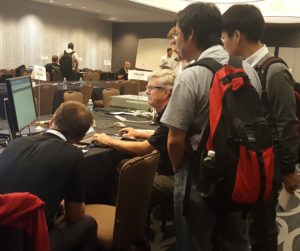 c Storage, and SMB3 plugfests; ten Birds-of-a-Feather Sessions, and amazing networking among 450+ attendees. Sessions on NVMe over Fabrics won the title of most attended, but Persistent Memory, Object Storage, and Performance were right behind. Many thanks to SDC 2016 Sponsors, who engaged attendees in exciting technology discussions.
c Storage, and SMB3 plugfests; ten Birds-of-a-Feather Sessions, and amazing networking among 450+ attendees. Sessions on NVMe over Fabrics won the title of most attended, but Persistent Memory, Object Storage, and Performance were right behind. Many thanks to SDC 2016 Sponsors, who engaged attendees in exciting technology discussions.
For those not familiar with SDC, this technical industry event is designed for a variety of storage technologists at various levels from developers to architects to product managers and more. And, true to SNIA’s commitment to educating the industry on current and future disruptive technologies, SDC content is now available to all – whether you attended or not – for download and viewing.
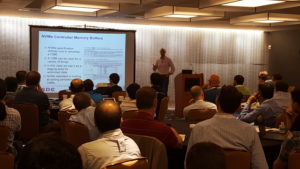 You’ll want to stream keynotes from Citigroup, Toshiba, DSSD, Los Alamos National Labs, Broadcom, Microsemi, and Intel – they’re available now on demand on SNIA’s YouTube channel, SNIAVideo.
You’ll want to stream keynotes from Citigroup, Toshiba, DSSD, Los Alamos National Labs, Broadcom, Microsemi, and Intel – they’re available now on demand on SNIA’s YouTube channel, SNIAVideo.
All SDC presentations are now available for download; and over the next few months, you can continue to download SDC podcasts which combine audio and slides. The first podcast from SDC 2016 – on hyperscaler (as well as all 2015 SDC Podcasts) are available here, and more will be available in the coming weeks.
SNIA thanks all its members and colleagues who contributed to make SDC a success! A special thanks goes out to the SNIA Technical Council, a select group of acknowledged industry experts who work to guide SNIA technical efforts. In addition to driving the agenda and content for SDC, the Technical Council oversees and manages SNIA Technical Work Groups, reviews architectures submitted by Work Groups, and is the SNIA’s technical liaison to standards organizations. Learn more about these visionary leaders at http://www.snia.org/about/organization/tech_council.
And finally, don’t forget to mark your calendars now for SDC 2017 – September 11-14, 2017, again at the Hyatt Regency Santa Clara. Watch for the Call for Presentations to open in February 2017.
The Changing World of SNIA Technical Work – A Conversation with Technical Council Chair Mark Carlson
 Mark Carlson is the current Chair of the SNIA Technical Council (TC). Mark has been a SNIA member and volunteer for over 18 years, and also wears many other SNIA hats. Recently, SNIA on Storage sat down with Mark to discuss his first nine months as the TC Chair and his views on the industry.
Mark Carlson is the current Chair of the SNIA Technical Council (TC). Mark has been a SNIA member and volunteer for over 18 years, and also wears many other SNIA hats. Recently, SNIA on Storage sat down with Mark to discuss his first nine months as the TC Chair and his views on the industry.
SNIA on Storage (SoS): Within SNIA, what is the most important activity of the SNIA Technical Council?
Mark Carlson (MC): The SNIA Technical Council works to coordinate and approve the technical work going on within SNIA. This includes both SNIA Architecture (standards) and SNIA Software. The work is conducted within 13 SNIA Technical Work Groups (TWGs). The members of the TC are elected from the voting companies of SNIA, and the Council also includes appointed members and advisors as well as SNIA regional affiliate advisors. 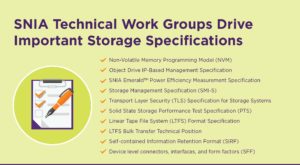
SoS: What has been your focus this first nine months of 2016?
MC: The SNIA Technical Council has overseen a major effort to integrate a new standard organization into SNIA. The creation of the new SNIA SFF Technology Affiliate (TA) Technical Work Group has brought in a very successful group of folks and standards related to storage connectors and transceivers. This work group, formed in June 2016, carries forth the longstanding SFF Committee work efforts that has operated since 1990 until mid-2016. In 2016, SFF Committee leaders transitioned the organizational stewardship to SNIA, to operate under a special membership class named Technology Affiliate, while retaining the long standing technical focus on specifications in a similar fashion as all SNIA TWGs do.
SoS: What changes did SNIA implement to form the new Technology Affiliate membership class and why?
MC: The SNIA Policy and Procedures were changed to account for this new type of membership. Companies can now join an Affiliate TWG without having to join SNIA as a US member. Current SNIA members who want to participate in a Technology Affiliate like SFF can join a Technology Affiliate and pay the separate dues. The SFF was a catalyst – we saw an organization looking for a new home as its membership evolved and its leadership transitioned. They felt SNIA could be this home but we needed to complete some activities to make it easier for them to seamlessly continue their work. The SFF is now fully active within SNIA and also working closely with T10 and T11, groups that SNIA members have long participated in.
SoS: Is forming this Technology Affiliate a one-time activity?
MC: Definitely not. The SNIA is actively seeking organizations who are looking for a structure that SNIA provides with IP policies, established infrastructure to conduct their work, and 160+ leading companies with volunteers who know storage and networking technology.
SoC: What are some of the customer pain points you see in the industry?
MC: Critical pain points the TC has started to address with new TWGs over the last 24 months include: performance of solid state storage arrays, where the SNIA Solid State Storage Systems (S4) TWG is working to identify, develop, and coordinate system performance standards for solid state storage systems; and object drives, where work is being done by the Object Drive TWG to identify, develop, and coordinate standards for object drives operating as storage nodes in scale out storage solutions. With the number of different future disk drive interfaces emerging that add value from external storage to in-storage compute, we want to make sure they can be managed at scale and are interoperable.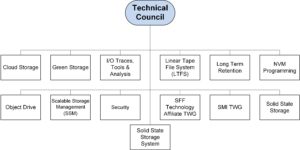
SoS: What’s upcoming for the next six months?
MC: The TC is currently working on a white paper to address data center drive requirements and the features and existing interface standards that satisfy some of those requirements. Of course, not all the solutions to these requirements will come from SNIA, but we think SNIA is in a unique position to bring in the data center customers that need these new features and work with the drive vendors to prototype solutions that then make their way into other standards efforts. Features that are targeted at the NVM Express, T10, and T13 committees would be coordinated with these customers.
SoS: Can non-members get involved with SNIA?
MC: Until very recently, if a company wanted to contribute to a software project within SNIA, they had to become a member. This was limiting to the community, and cut off contributions from those who were using the code, so SNIA has developed a convenient Contributor License Agreement (CLA) for contributions to individual projects. This allows external contributions but does not change the software licensing. The CLA is compatible with the IP protections that the SNIA IP Policy provides to our members. Our hope is that this will create a broader community of contributors to a more open SNIA, and facilitate open source project development even more.
SoS: Will you be onsite for the upcoming SNIA Storage Developer Conference (SDC)?
MC: Absolutely! I look forward to meeting SNIA members and colleagues September 19-22 at the Hyatt Regency Santa Clara. We have a great agenda, now online, that the TC has developed for this, our 18th conference, and registration is now open. SDC brings in more than 400 of the leading storage software and hardware developers, storage product and solution architects, product managers, storage product quality assurance engineers, product line CTOs, storage product customer support engineers, and in–house IT development staff from around the world. If technical professionals are not familiar with the education and knowledge that SDC can provide, a great way to get a taste is to check out the SDC Podcasts now posted, and the new ones that will appear leading up to SDC 2016.